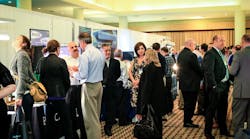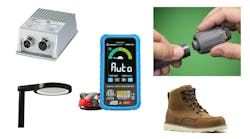Held on March 20 at the Hotel Pennsylvania in New York City, the Seventh Annual LEDucation conference, presented by The Designers Lighting Forum of New York (DLFNY), attracted more than 3,000 designers, engineers, educators, contractors, students, and manufacturers. Offering attendees the chance to learn more about solid-state light sources, standards, and controls, the meeting featured an exhibit area with more than 150 manufacturers and distributors displaying their products and services. Additionally, five seminars (highlighted below) were offered throughout the day.
In the "LED – Next Generation Luminaires (NGL)" session, the U.S. Department of Energy (DOE), the Illuminating Engineering Society of North America (IESNA), and the International Association of Lighting Designers (IALD) jointly announced the results of the 2013 Next Generation Luminaires (NGL) Solid-State Lighting (SSL) Design Competition for indoor products. In introductory remarks, DOE solid-state lighting program manager James Brodrick noted that "awards by the NGL judges, who address performance issues, such as dimming, flicker, and reliability along with other benchmarks, is not given lightly."
Barbara Horton, principal, HLB Lighting Design, described how the 11 judges, meeting in Arlington Heights, Ill., examined the products for color quality, light distribution, glare control, appearance, energy efficiency, and serviceability, as well as photometric analyses and other documentation.Complete documentation, including luminaire and component specification sheets, LM-79 test reports, luminaire maintenance projections, and warranties on 99 products were reviewed. Horton also observed that the 2013 winners have significant color improvement compared to previous years — and that efficacy is also continuously rising. For example, the products this year averaged 75 lpw, compared to 37 lpw in 2008.
Ruth Taylor, project manager, Pacific Northwest National Laboratory, Richland, Wash., presented the 28 products receiving the designation as "Recognized" and three of those products received the additional designation as "Best in Class." Four others, not listed in the recognized category, were classified as "Notable" for their color temperature adjusting capabilities.
In the"Zhaga Standard – LRD Engine Specification & Dimming Standards" session, Greg Balluccio, director of LED business development, Leviton Mfg. Co., Melville, N.Y., described the Zhaga Consortium, an international industry organization that develops standards for the physical, electrical, thermal, and photometric parameters of LED light sources/modules. The goal of the group is to reduce both unnecessary cost and risk in selecting luminaires, as the technology improves and evolves. In addition, manufacturers can offer more choices in CRI, CCT, color stability, lumen levels, lifetime, etc., while making it easier for the luminaires to be serviced, repaired, and upgraded.
An LED light engine is the combination of an LED module and its associated electronic control gear (driver). Users should be able to buy the same type of luminaire years later, knowing that an upgraded and reliable light engine will be available on the market. In general, the goal of Zhaga is to help solid-state luminaire makers reduce costs and remove inconsistent performance in the supply chain.
Founded in February 2010 and made up of more than 200 members, the association is presently creating seven documents called "Books" that define the interface specifications.
Lindsay Stefans, project manager, Philips Lighting, explained some of the efforts underway to make phase-cut dimmers more compatible with LED sources. One effort is the NEMA Standard for SSL 7A-2012, Phase Cut Dimming for Solid State Lighting. A lack of consensus regarding off-state current is delaying the finalization of Part A of this document. The claim that LED lighting products are dimmable is often contracted by experiences in the field, especially with phase-cut dimmers, which are designed to work with incandescent lamps and thus may have compatibility problems with LED drivers.
In the "Anatomy of a Project – The Use of LEDs for Interior & Exterior"session, Janet Lennox Moyen and C. Brooke Sibler, Jan & Brooke, Luminae, described the selection of LED equipment at a time when both the chips/modules and the luminaires are under constant development. While recognizing that standards are lagging at present, the designers note that important considerations for any lighting project include: payback analysis, photometric data, fixture flexibility, thermal management, color stability, and range of fixture selection. Additionally, while lumen output information on individual LED sources is available, candlepower information is not. Therefore, direct comparison is not possible, and visual inspection is the only true metric.
Designers want to be able to specify drivers that provide smooth dimming and consistent color and brightness. Future driver products should be able to integrate with all types of solid-state lighting applications and communicate with a variety of lighting control systems.
In the "Controlling LED Lighting" session, Craig Fox, ETC Architectural and Jesse Lowenstein, iGussinin Lighting USA, discussed the basic components of an LED system: the controller, driver, and lamp module fixture. They also described the methods used for dimming, such as: 0 to10 V analog; Digital Addressable Lighting Interface (DALI) open standard protocol, which sends data packets over a bus network; and the DMX protocol, the theatrical lighting standard, which is also used for architectural spaces. They also recognized that the governmental laws and regulations regarding lighting control should also be adaptive to users' health needs and comfort factors.
In the "Can LEDs Make Code Compliance Easier?" session, Michael W. Mehl, director, Lighting Department, Jaros, Baum & Bolles, New York, and Marty Salzberg, senior associate, Cline Bettridge Bernstein Lighting Design, New York, noted that the basis for energy code requirements is the Energy Conservation and Production Act (amended by EPAct 1992), which calls for each state to adopt/develop various codes/standards to meet these requirements. In U.S. code history, the two models are: the International Energy Conservation Code IECC -2001 Residential and Commercial Code and the ANSI/ASHRAE/IESNA Standard 90.1, "Energy Standard for Buildings Except Low-Rise Residential Buildings," (ASHRAE 90.1). A state can adopt either one of the documents, or it can develop one of its own. The best known individual state code is California Title 24.
The U.S. Department of Energy (DOE) is seeking more compatibility between the two documents in the future, while looking forward to increasing the energy efficiency requirements, especially as LED products grain greater efficacy.
The NY State Energy Conservation Construction Code (ECCC) is a version of the IECC, but it allows use of ASHRAE 90.1 as an alternative compliance path for a commercial project. All trades on a specific construction project must use the same code — either the IECC of NY State or ASHRAE 90.1.C. The speakers also mentioned that New York City has its own Energy Conservation Code, which is incorporated into the New York City Building Code. In addition, specific lighting requirements are found in the city’s local laws.
The ASHRAE 90.1-2010 version of the standard is 18% more efficient that the 2007 version, since the lighting requirements include daylighting control and skylights, expanded occupancy sensor control, exterior after-hours lighting control, parking garage daylight and after-hours control, stairwell control (unoccupied 50% reduction), control incentives for advanced controls, receptacle 50% auto shut-off control, and functional testing (commissioning). The DOE requires states to report on a compliance path for the 2010 version by October 2013. These more stringent requirements most likely are a step toward regulations that mandate net-zero building design.



